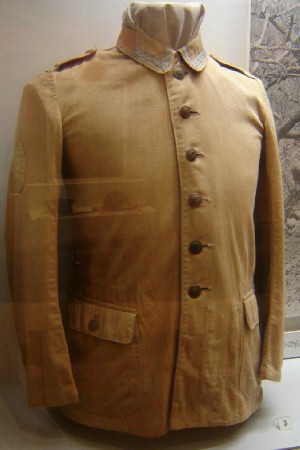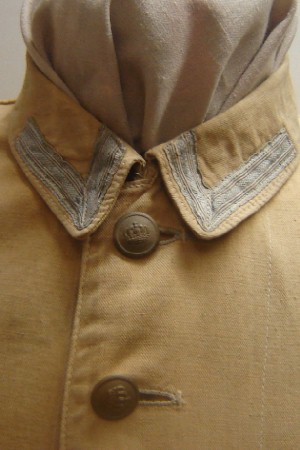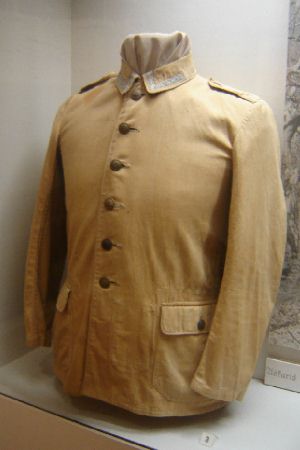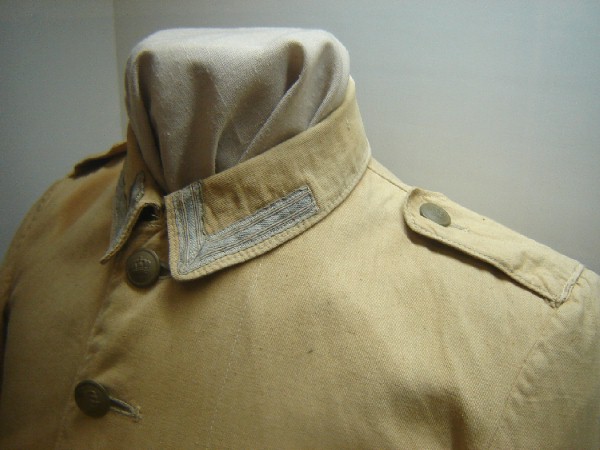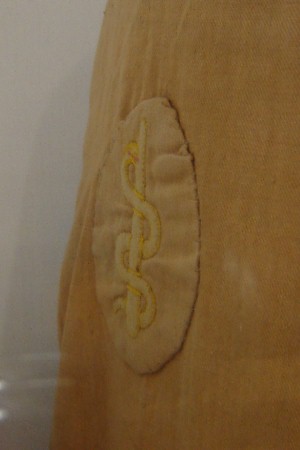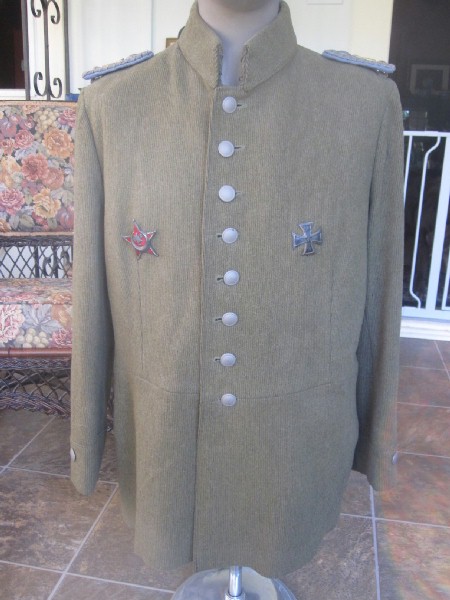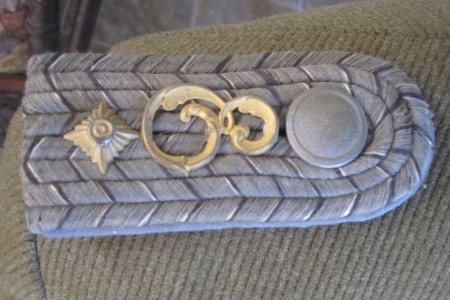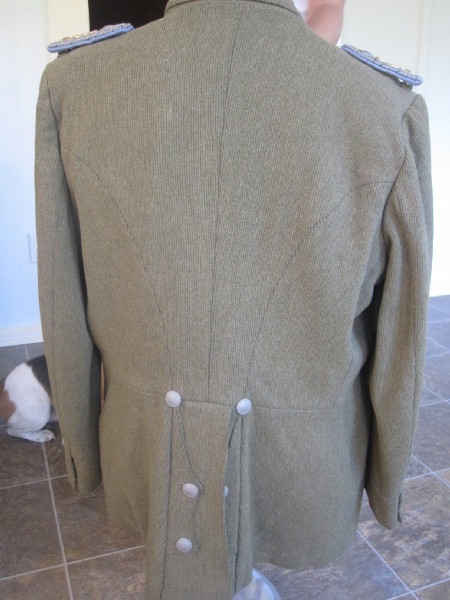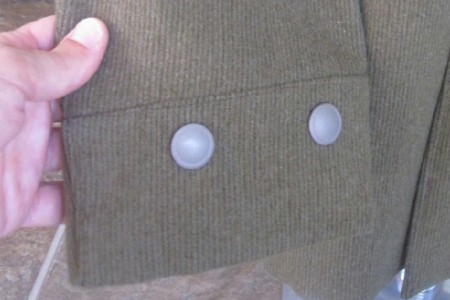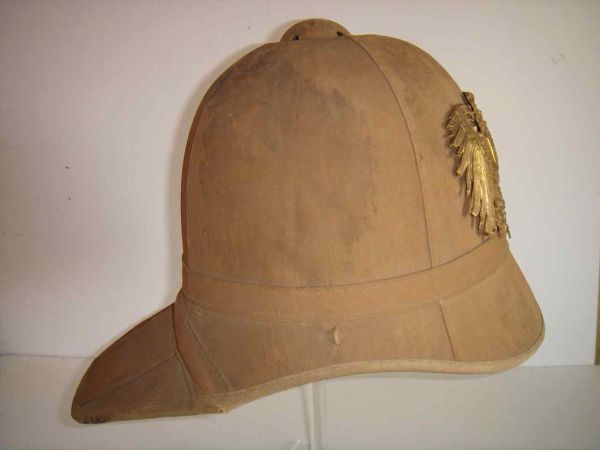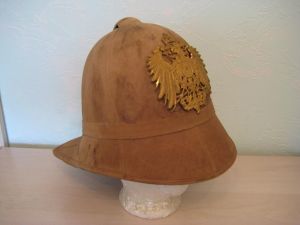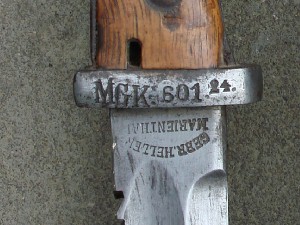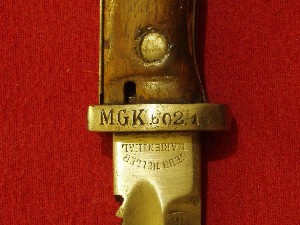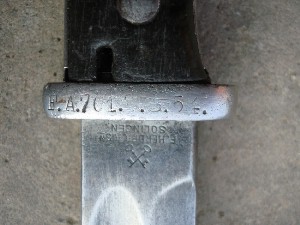|
Tropical Uniforms of the Pascha
I and II Expeditions
|
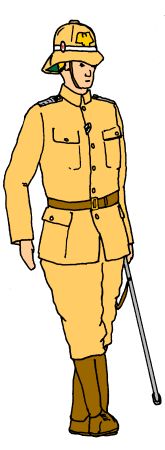 |
 |
 |
 |
 |
|
Figure 1
Infantry Officer |
Figure 2
Cavalry NCO |
Figure 3
Infantryman |
Figure 4
Infantryman |
Figure 5
Musician |
Uniforms of the Pascha I and II
Expeditions
Although most German troops in the Ottoman Empire during the First World
War wore
either standard German
Field Grey Uniforms (when serving in German units) or
Ottoman Army Uniforms
(when serving in Ottoman Units), from 10th July 1917 Tropical Uniforms
were also authorised for the Pascha II Expedition (often known as the "Asienkorps")
and other troops within the Ottoman Empire. Some photographs apparently
dated 1916 also show German troops in the same khaki uniform as later
authorised for the Asienkorps. The exact date of its first use is so far
unknown although the tunic is usually referred to as the 1917 model.
These tropical uniforms were intended for
Summer wear and both the
Pascha I and II Expeditions also brought their field grey uniforms and greatcoats with them
to Palestine for wear
during cold weather. Due to the khaki uniforms similarity to
British
uniforms and other impracticalities in wear and issue, in the latter half of 1918 they were
largely replaced by field grey. Some period photographs show members of the
Asienkorps wearing a mixture khaki and field grey (for example a khaki
tropical helmet with khaki tunic and field grey trousers and puttees).
Tropical Uniforms
The tunics were mostly newly
designed and made, although based on previous Schutztruppe, Seebatallion
and East Asian experience. Some tunics may have come from Schutztruppe
stocks. The headdress came in the from of the
tropical helmet or khaki field cap both of which were from former East
Asian stocks. There were several variaties of uniform worn.
Medical NCOs 1917 Pascha Tropical Uniform
Photos by C
Dale from the
Bavarian Army Museum
1917 Other Ranks Khaki Uniform
The other ranks of the Pascha I Expedition wore a khaki tunic with a
plain stand and fall collar, plain cuffs,
plain buttoned hip pockets, plain rear and six buttons down the
front. Shoulder straps were usually plain khaki, as seen on
surviving examples. Some sources (such
as "The German Army 1914-18" by DSV Fosten,
RJ Marrion and G Embleton
and
"Imperial German Army Handbook
1914-18" by D Nash) refer to unit numbers in red with piping in arm
of service colours. I have so far found no period photographic
proof of shoulder strap insignia. The buttons were as for the rest of the German army, dull
yellow metal (with pioneers possibly wearing dull white metal) and bearing the
Prussian crown (or other state device- see photo above).
NCO rank insignia was the
same as worn by the rest of the German army at this late stage in
the war, short lace at the front of the collar (see photo above) with dull metal
collar buttons (see NCO Rank Insignia).
Some photographs show NCOs wearing lace around the whole edge of
their collars.
Specialist insignia was also worn as for the rest of the German army
except the badges were made on a khaki backing to match the uniform
(see photo above of a khaki medics badge on the arm and also Specialist Insignia Page).
1896 Schutztruppe Khaki Uniform
Some period photographs of the Pascha II Expedition show them wearing a
khaki tunic with pleated breast
pockets. This tunic was of identical cut to the
1896 Schutztruppe Khaki
Uniform but without the blue piping. A few photographs of the
Asienkorps show the tunic still with the Schutztruppe other ranks
shoulder straps of twisted cords in the imperial colours and
Schutztruppe style NCOs rank chevrons. This would imply that the
tunics came from surplus Schutztruppe stock rather than being newly
manufactured for the Asienkorps.
Officers Khaki Uniform
The officers tunics were similar to those of the other ranks but all
had breast pockets. Being privately purchased they were usually of
better quality and had variations in cut, such as sometimes having
higher collars, pleated pockets, scalloped pocket flaps, eight
buttons down the front or a fly front. Variations in the shade of
khaki were also seen and some uniforms were made in corduroy rather
than khaki cloth. Officers shoulder straps were worn, the same
as on other army uniforms (see
Officers Rank Insignia).
Train Officers Privately
Purchased Corduroy Tunic
Photos © Private US Collector (see
Bagdad Train Tunic Page)
Officers White Uniforms
Officers were also authorised to wear privately purchased white tropical
uniforms for use away from the front line. These white uniforms were of
the same cut as the khaki uniforms with the same officers shoulder
straps. They were also privately tailored and therefore subject to
variations in cut. Matching white peaked field caps, trousers and
ankle boots were also worn.
Trousers
Matching khaki trousers were also
authorised and issued. They were plain without piping. Officers had
khaki trousers, riding breeches or white trousers privately tailored.
Tropical Helmet
The tropical helmet most commonly issued was of the 1902 Bortfeldt khaki
pattern and came from existing surplus East Asian
Brigade stock. Some photographs show that a different lower khaki
helmet with a rounder brim was also issued. Both types of helmet came
with a removable khaki neckshade. Officers sometimes wore privately
purchased helmets.
The
East Asian Bortfeldt helmet had a yellow metal imperial eagle on the front
(white metal for Pioneers and Staff Officers). This
was usually removed for active service. The Bortfeldt and other helmets were worn
with a hatband in arm of service colour. It would appear from period
photographs that the same arm of service colours as the East Asian
Brigade were used.
| Arm
of Service Insignia on the Tropical Helmet |
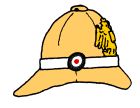 |
 |
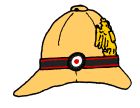 |
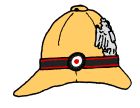 |
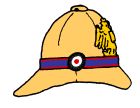 |
|
Infantry |
Cavalry |
Artillery and Transport |
Pioneers |
Medics |
What strikes me as odd is how
very few photographs (only two that I know of) show pale or white
infantry hatbands being worn. Perhaps I have just missed infantry
photographs and always seen artillery, machine gunners and pioneers
wearing their black hatbands edged in red. Or perhaps the infantry wore
darker hatbands in Palestine than in China. It might be that they wore red
hatbands as the infantry wore on their field caps. Osprey's "The German
Army in World War One (3)" offers another possibility, an illustration
by Ramiro Bujiero. shows an infantryman of the Asienkorps with a yellow
hatband, which would probably have appeared dark in orthochromatic
photographs of the period. No further explanation or source for the use
of yellow is given in the text.
A large imperial cockade was pinned on
the right hand side of the hatband. In some period photographs this cockade can be
seen worn at the front of the hatband and in some photographs it
is worn on the left hand side. Some tropical helmets are seen worn
without hatband or cockade. The tropical helmet was
eventually withdrawn from use in action as
it looked too similar to the Wolseley tropical helmet worn by British
troops and thus caused friendly fire incidents.
Khaki Field Cap
The khaki field cap authorised on 1st June 1918 was also of the type previously issued to
the East Asian troops and had a small imperial cockade above a
state cockade with no hatband or piping colours. It had a rounded grey
leather peak
and brown leather chinstrap. At least two versions of this hat were
issued, one with a longer peak to shade the sun better. Like the tropical helmet, the peaked cap could be worn with
a removable khaki neck shade.
Footwear
Most other ranks wore brown leather ankle boots. It may be
that some troops wore blackened leather boots as worn on European fronts
in the later stages of the war. With the boots were worn puttees. Several sources state that khaki puttees
were issued, though the uniform regulations of 10th July 1917 do not
mention the colour of the puttees. Most period photographs show the
soldiers' puttees as being
noticeably darker than the rest of the khaki uniform. Some of these photographs
may simply show the lower leg in the Sun's shade,
but others indicate that field grey puttees were more commonly worn.
Some period photographs show white ankle boots worn
without puttees by members of the
Pascha II Expedition both in training in Germany and in Palestine. I
have never seen any close up photographs or modern surviving examples
to see any details of them.
Most photographs of officers show them
wearing privately purchased ankle boots and leather gaiters. White shoes
or ankle boots could be worn with the officers white tropical uniform.
Other photographs show officers wearing puttees and ankle boots as worn
by the other ranks.
Other Items of Tropical Clothing
Other items of tropical clothing and equipment also
used by the Asienkorps included khaki sand scarves,
mosquito veils and sand goggles.
Equipment
The equipment carried by members of the Asienkorps was of the same type
as used by the German army on European fronts at this stage in the war,
consisting of backpack, tent quarter, water bottle, bread bag and
entrenching tool. Gas masks do not appear to have been commonly carried.
The straps and belt were of blackened leather with 1909 pattern
ammunition pouches and held at the front with a dull grey belt buckle
usually featuring the Prussian crown surrounded by a laurel wreath and
the motto "Gott mit Uns". The different German kingdoms each
had their own design of royal crown and motto on their troops belt
buckles but these variations were increasingly being replaced by
Prussian versions as the war went on.
Weapons
Most photographs show the use of K98az carbines with S84/98 bayonets.
Pistols, swords and trench knives were also issued where appropriate.
| |
|
|
| |
The Illustrations
Figure 1 is based on a
photograph of an Infantry Officer of the Pascha II Expedition parading through
Istanbul on their way to the frontline. He wears a privately purchased
officer's four pocket khaki uniform as
described above. His shoulder straps are the same as worn as on his
European field grey uniform (see Officers Rank Insignia Page).
Note the large yellow metal imperial eagle of the front of the
Bortfeldt tropical helmet which was usually removed on active duty, the hatband
in arm of service colour (in this case white for infantry) and the large
imperial cockade on the right hand side.
This officer wears a Prussian Iron Cross second class
medal ribbon in
his second buttonhole. Unlike in the colonies where it was rare to see
officers and more so other ranks wearing medals especially in the field,
most of the servicemen in the German units in Palestine had seen recent action on the Western and Eastern fronts and so
German medals such as this Prussian Iron Cross, as well as Ottoman
awards such as the Turkish War medal were commonly worm (see
Medals Page).
He wears a plain brown leather belt with an
open buckle which replaced the Prussian officers silk waist band in
action during the First World War. He wears privately purchased brown
leather gaiters and ankle boots. This officer's sword is probably the 1889
Infantry officers sword with a Prussian Portepee sword knot (see
Sword Knots). The sword would not have been
carried in action.
Figure 2 is based on a
photograph of an Cavalry NCO of the Pascha I or II Expedition. He wears the
other ranks khaki uniform without breast pockets, as described above. His rank ("Unteroffizier") is shown by
a strip of grey lace lace around
the whole front and lower edges of the collar as was usually seen
earlier in the war. His tropical helmet is not of the Bortfeldt
shape but a different rounder and wider type. It has the red hatband of
the cavalry but no imperial eagle front plate. A large imperial cockade
may be worn on the right hand side but is out of view in from this
angle.
He wears khaki riding breeches with European
issue field grey puttees and is armed with a Mauser K98az carbine with
a cover over the the stock to protect it from the elements.
Figure 3 is based on a
photograph of an Infantryman of the Pascha II Expedition taken in Palestine in 1918. He
also wears the 1917 other ranks khaki uniform as described above. In the
second buttonhole he wears an Iron Cross, second class and across his
right breast is a Prussian marksmanship award lanyard in white and black
cords (see
Specialist Insignia Page).
Marksmanship awards were not commonly worn at this late stage in the
war. He wears the 1918 Khaki Field Cap, with long peak and neckshade.
Note the imperial and state cockades. He carries 1909 ammunition pouches
and a K98az carbine. Figure 4 is based on a photograph
of an Infantryman of the
Pascha II Expedition taken in Palestine in 1918. This figure shows
the plain rear of the khaki tunic and the khaki field cap with
neckshade attached by cords through the shade to the hatband of the
cap. Note also the Y shaped straps of the equipment and the bread bag and
all
important water bottle. Figure 5 is based on a photograph
of a Bandsman of the
Pascha II Expedition taken in Palestine in 1918. His tunic is
the 1896 Schutztruppe type. Note the Schutztruppe other ranks
shoulder straps of twisted cords in the imperial colours and
Schutztruppe style NCOs rank chevrons. As a musician he wears
swallows nests on his shoulders, though these would have been
removed for active duties). In his second buttonhole he wears an
Iron Cross, second class medal and ribbon, with a Turkish War Medal
(sometimes known as the Iron Crescent or Gallipoli Star) on his
right breast (see
Medals Page).
His helmet is the Bortfeldt 1902
tropical helmet with a hatband in arm of service colours (in this
case black edged in red for transport troops- his unit is KP505).
See below for close ups of this original photograph. |
|
| |
|
|
|
|
|
Period Photographs
|
|
|
|

Transport troops of the 505th
Motorised Unit ("Kraftwagen-Park
505") of the Asienkorps (see the
AGW14-18 Forum for a more full breakdown of
transport troops in the Pascha Expeditions). They wear khaki tropical
uniforms and 1902 Bortfeldt tropical helmets. They are armed
with the K98az carbine.
Photos © Joe Robinson
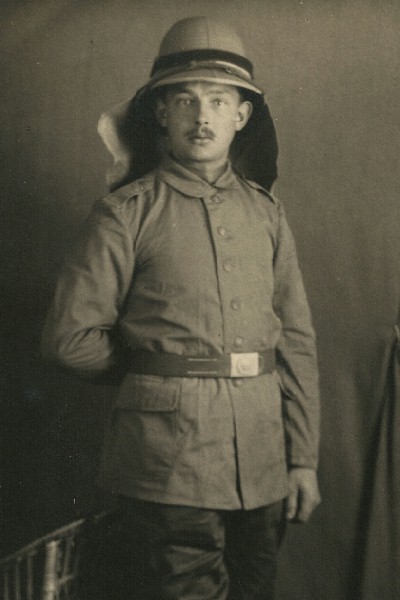 |
|
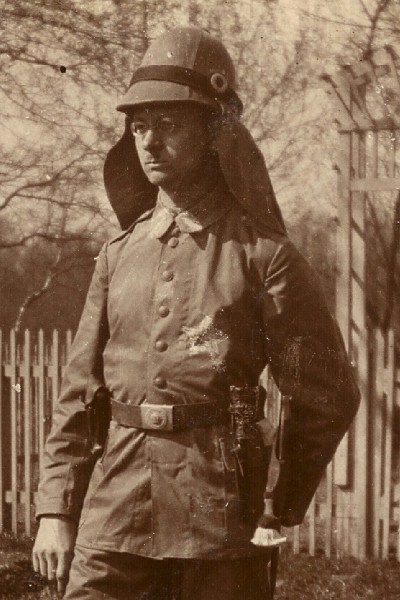 |
| |
|
|
|
Above are photographs of two soldiers of
the Pascha II Expedition, both probably taken in Germany prior to
their service in Palestine. Both wear the 1917 other ranks khaki
uniform with other ranks leather belts and one piece metal buckles.
They wear Bortfeldt 1902 khaki tropical helmets without eagles but
with neckshades hatbands in arm of service colours. Note the figure
on the right unusually wears his imperial cockade on the left. Also
note his other ranks bayonet knot in company colours (see
Bayonet Knots Page).
Photo © Joe Robinson
The
photograph on the right is of an artillery NCO of the Pascha I
Expedition taken in May 1916. He wears the khaki tunic without
breast pockets. According to
"Die feldgraue Uniformierung
des deutschen Heeres 1907-1918" by J Kraus
and W Hanne this uniform was only
authorised from 10th July 1917, so unless the date written on the
back of this photograph is wrong, the uniforms were in fact issued
over a year before then.
His rank, Sergeant, is shown
by the use of wartime dull grey lace around the collar edge and a
button towards the rear of his collar (just visible on his right
side). The trousers look like they are of thicker
material, probably wool and are piped down the outside seem in black
for artillery. From these details it would seem they are probably
field grey trousers (or riding breeches). The puttees as well are most
likely field grey issue as worn in Europe.
He wears the 1902 Bortfeldt tropical helmet. It
has
the same yellow metal imperial eagle and arm of service colour hatband
(in this case black edged with red for artillery) as worn by the East
Asian troops. It cannot be seen from this angle if he is also wearing
the large imperial cockade on the right hand side. He does however
wear the issue khaki neckshade.
His sword is the Prussian artillery other
ranks curved sabre with an NCOs Faustriemen sword knot.
Photo © Roy Williams (See
Full Size Version) |
|
|
|
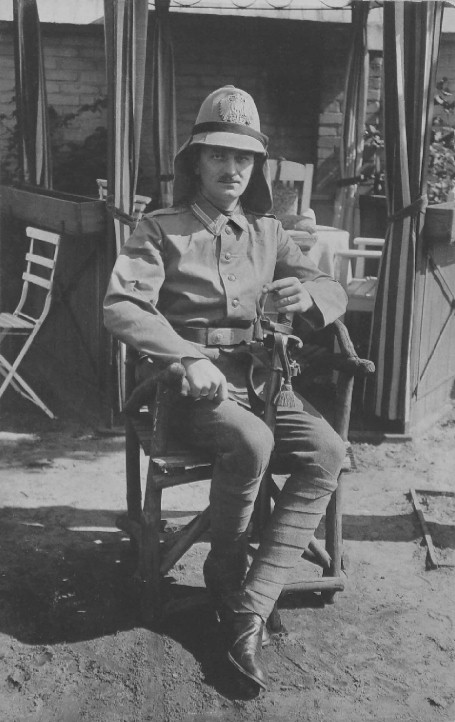 |
|
|
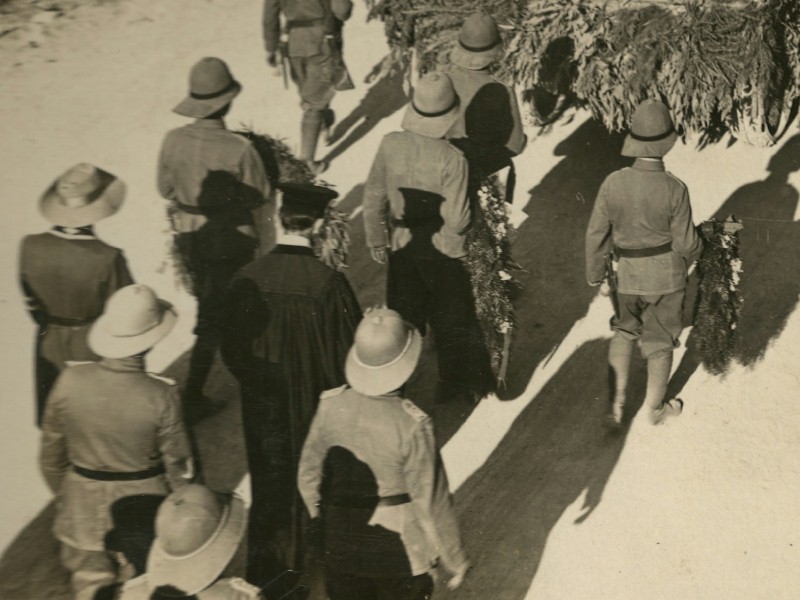
This photograph
of a funeral procession for an Asienkorps soldier clearly
shows the difference between the other ranks Bortfeldt
tropical helmet with its squared off folding rear peak and
the rounder private purchase helmets of the officers. The
officers helmets appear to be more similar to the
Schutztruppe 1913 helmets.
Photo © Joe Robinson
|
|
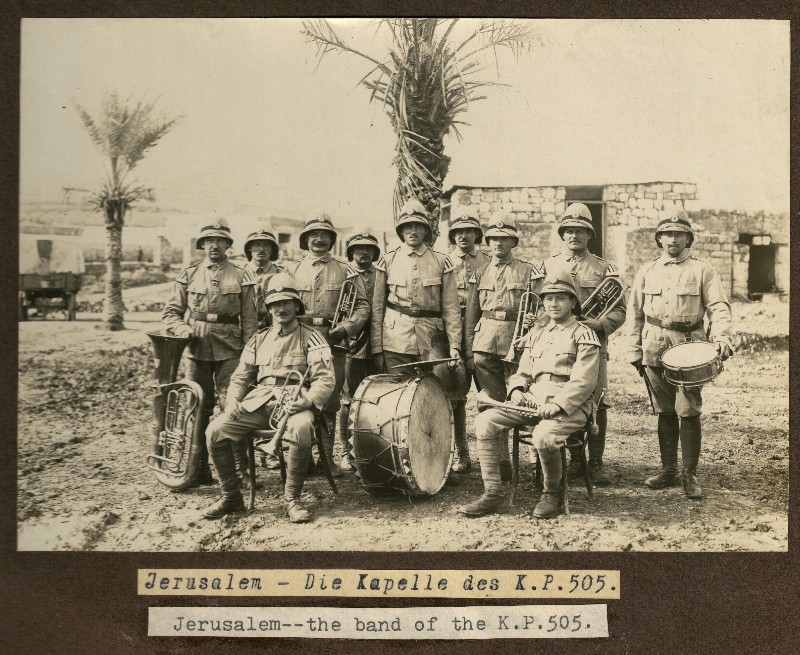
The band of the 505th
Motorised Unit of the
Asienkorps in 1917 or 1918. They all wear the 1902 Bortfeldt
helmet without the eagle but with hatbands in arm of service
colour (black with red edging for transport troops) and an
imperial cockade worn at the front. They wear the
1896 Schutztruppe tunic. Note the Schutztruppe other ranks
shoulder straps of twisted cords in the imperial colours and
Schutztruppe style NCOs rank chevrons. Although at least one
NCO wears his rank insignia was buttons on the collar as was
standard army practice (see close ups below). Almost the
whole band wear musicians swallows nests with the bandleader
seated on the left being distinguished by fringed swallows
nests. Between them they wear several awards of the Iron
Cross and Turkish War Medal. They wear khaki trousers and
puttees with short marching boots.
Photo © Joe Robinson and
first seen at the
Pickelhaubes Forum
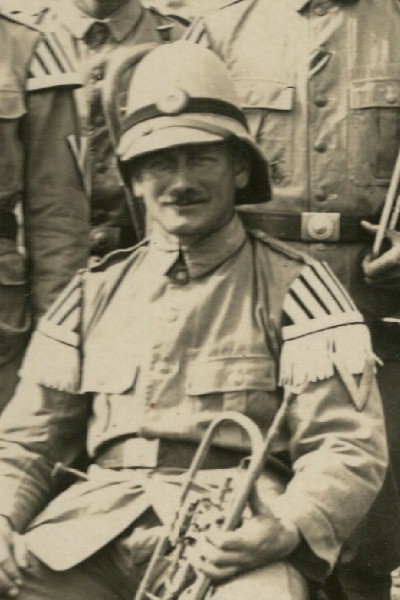 |
|
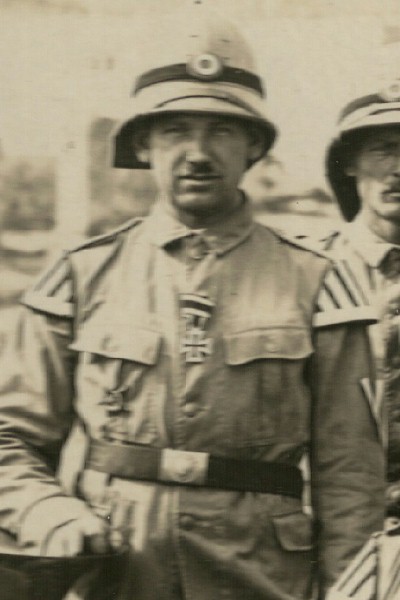 |
| |
|
|
| The Bandmaster with
fringed swallows nests and Schutztruppe style
Unteroffizier rank chevron. |
|
The tuba player,
note also the swallows nests and rank chevron on the
arm and the Prussian Iron Cross and Turkish War
Medals. |
| |
|
|
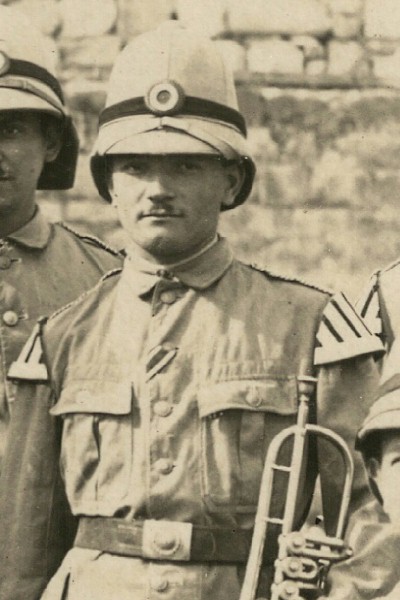 |
|
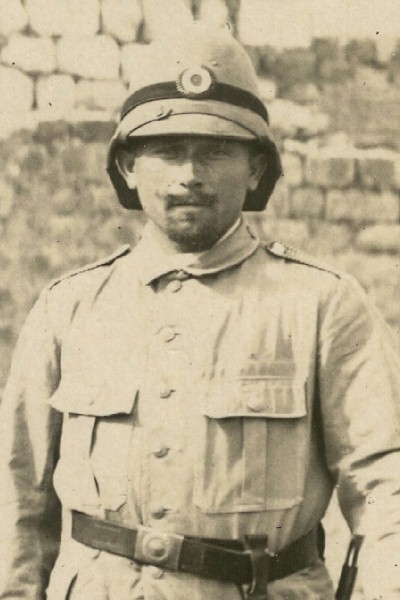 |
| |
|
|
| A
trumpeter, again note the swallows nests and
Prussian Iron Cross ribbon. The twisted cord
shoulder straps in imperial colours can be made out
here. |
|
A
drummer, again note the shoulder straps. Note the
Gefreiter rank insignia on the collar. He wears no
swallows nests. |

Another photograph of probably
of the same band, marching through Jerusalem. They wear the
same tropical helmets and uniforms as in the previous
photograph but without their removable musicians swallows
nests
Photo from Bundesarchiv /
WikiCommons
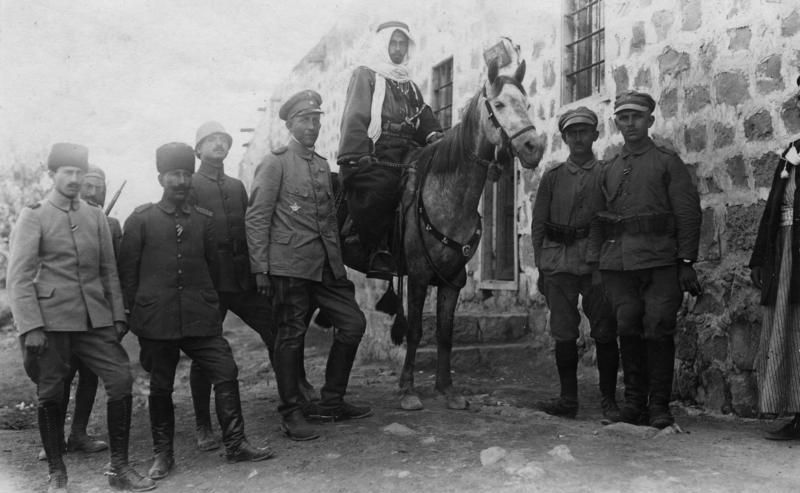
The Bedouin Sheikh, Yusuf Al
Ursan with Ottoman and German troops taken in Jordan in
1918. The German officer in the centre is Hauptmann
Justin. He wears an officers khaki tunic with breast and hip
pockets and his rank shown on his shoulder straps. On his
right breast he wears the Turkish War Medal (see
Medals Page), with other
medals just out of clear view on his left breast. He has two
thick stripes, probably red stripes for a staff officer, on
his field grey trousers. His cap maybe khaki or field grey
and has both imperial and state cockades.
The two German soldiers on
the right wear the other ranks 1916 khaki uniform without
breast pockets. They wear the khaki field cap with two
cockades, chinstrap and a long peak and matching khaki
trousers. The one on the right appears to wear marching
boots, while the one on the left has dark (probably field
grey) puttees and ankle boots. They both carry 1909
ammunition pouches. The soldier on the right has an Iron
Cross second class ribbon from his second button hole and a
marksmanship award on his right breast (see
Specialist Insignia Page).
Two of the Ottoman officers on the left of the photograph
also wear the Prussian Iron Cross.
Photo from Bundesarchiv /
WikiCommons
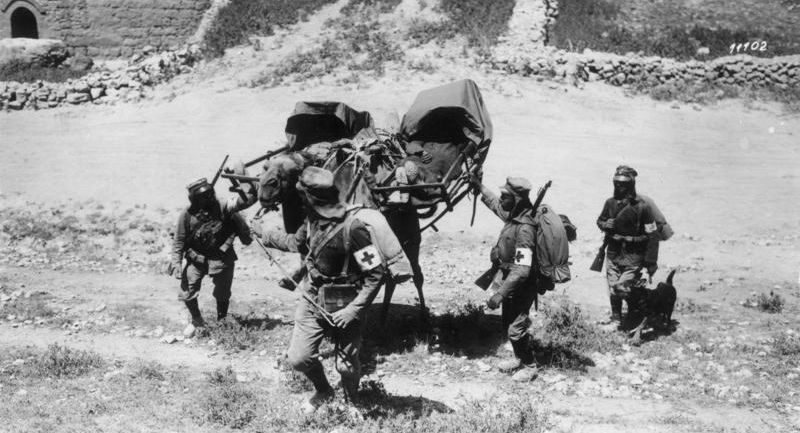
A medical unit of the
Asienkorps with a camel stretcher litter in Palestine in June 1918. The medics wear the 1917 tropical uniform with
breast pockets. They also wear 1918 khaki peaked field caps with
small imperial and state cockades and the issue neckshade.
Note also the red cross armbands.
Photo from Bundesarchiv /
WikiCommons

This photograph shows
officers of the Motorised units in Jerusalem around 1918.
They wear a mixture of privately purchased uniforms as
described with the close up photos below.
Photo © Joe Robinson
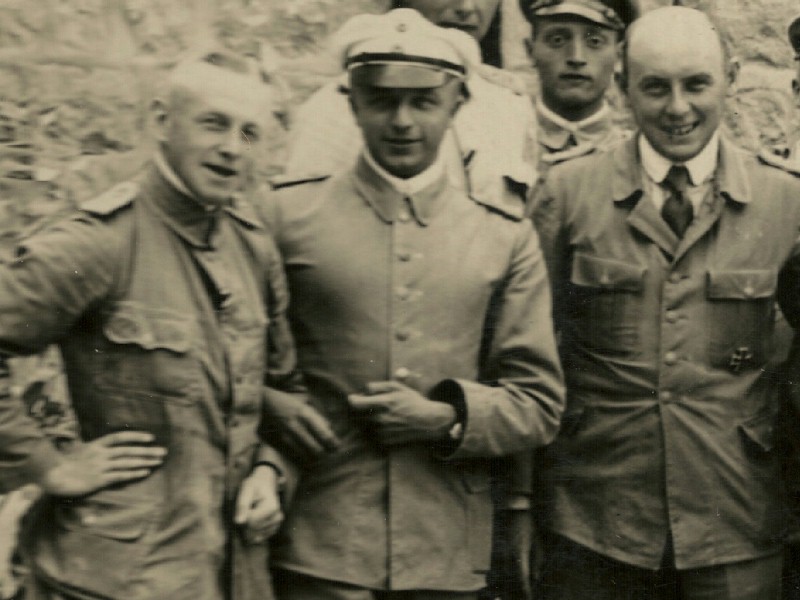
The officer on the left wears
a typical khaki Asienkorps officers privately purchased
tunic. Note the officers shoulder straps, high stand and
fall collar and unpleated breast pockets with scalloped
flaps. He wears an Iron Cross second class in his second
buttonhole.
The officer in the centre
wears a khaki tunic in the cut of the other ranks without
breast pockets and with a lower collar. Note the officers
shoulder straps though. He wears a white tropical field cap.
The officer on the right
wears another variation on the privately purchased officers
khaki tunic worn with the collar folded out. This tunic has
pleated breast pockets with straight flaps. Again note the
officers shoulder straps and Iron Cross first class on the
left breast.
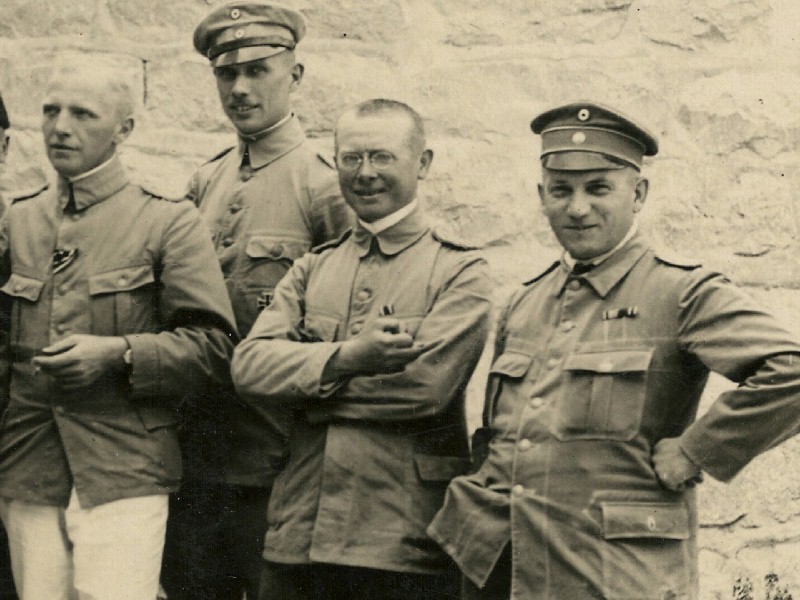
The officer on the left wears
a Schutztruppe style officers tunic. Note the short cuffs,
officers shoulder straps, high standing collar and sloped
pleated breast pockets with straight flaps. He wears an Iron
Cross second class and other medal in his second buttonhole.
The next officer standing
behind the others wears a typical khaki Asienkorps officers
privately purchased tunic. Note the officers shoulder
straps, high standing collar and unpleated breast pockets
with scalloped flaps. He wears an Iron Cross first class on
his left breast. His headdress is the 1918 khaki field cap.
The officer in the centre
wearing glasses is wearing a khaki tunic, though it is hard
to tell of which design without seeing the breast pockets.
Above the left breast pocket is an Iron Cross second class
worn as a miniature ribbon.
The officer on the right
wears an 1896 Schutztruppe other ranks khaki tunic but with
officers shoulder straps. Note the low stand and fall
collar, short cuffs and sloped pleated breast pockets with
straight flaps. He wears two or three medals as miniature
ribbons. His headdress is the field grey officers peaked
cap, with hatband in arm of service colour and two officers
cockades. |
|
Sources and Recommended Reading
"Die feldgraue Uniformierung
des deutschen Heeres 1907-1918" by J Kraus
and W Hanne
(Verlag
Militaria 2009)
"The German Army 1914-18" DSV Fosten,
RJ Marrion and G Embleton (Osprey 1978)
"The German Army in the First World War" J Kraus (Verlag
Militaria 2004)
"Imperial German Army Handbook
1914-18" D Nash (Ian Allen 1980)
"World War One German Army" S Bull (Brassey's 2000)
"The German Army in World War One (3)" N Thomas and R Bujiero (Osprey
2003)
...and a
Discussion on the Asienkorps at the Axis History Forum
|





